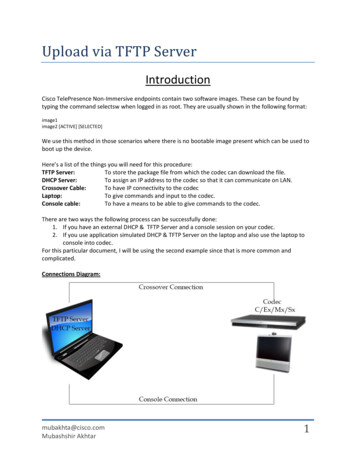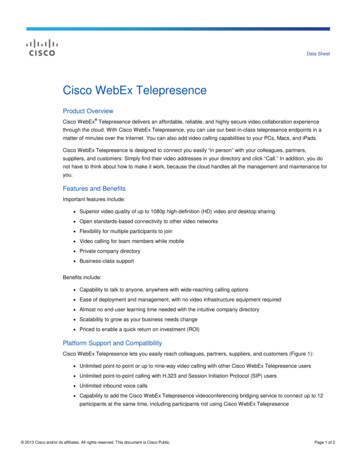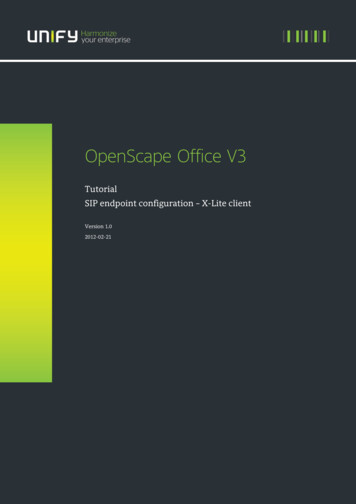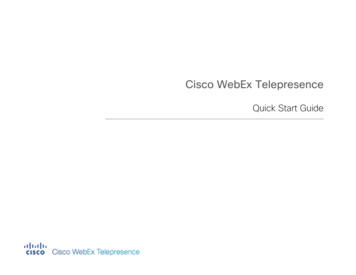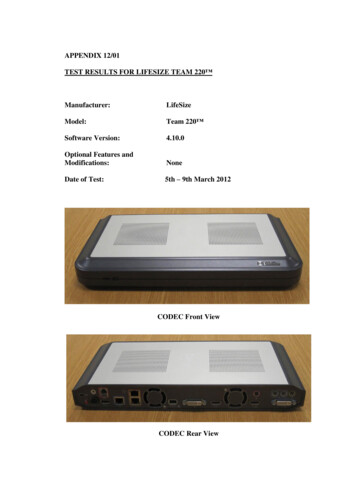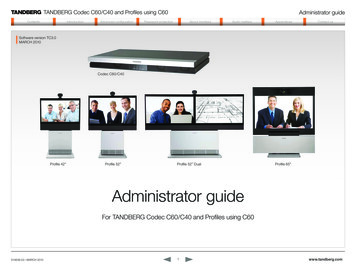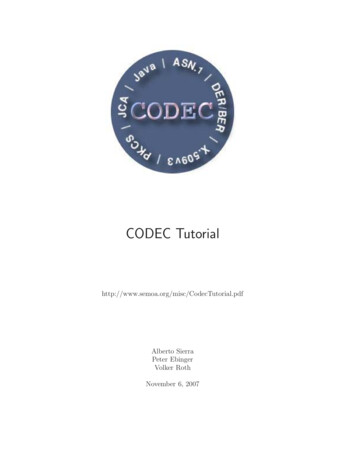
Transcription
CODEC fAlberto SierraPeter EbingerVolker RothNovember 6, 2007
Contents1 Introduction to CODEC32 Introduction to ASN.153 Simple Coding/Decoding Example94 How to implement SEQUENCE types145 How to implement SEQUENCE OF types236 Note about SET and SET OF types257 How to implement CHOICE types268 How to implement ENUMERATED types299 How to implement optional fields3110 How to implement tagging3711 How to implement default values4312 How to implement ANY types4613 The OID Registry50A Coding/Decoding Example53B SEQUENCE Example58C SEQUENCE OF Example66D CHOICE Example741
E ENUMERATED Example84F OPTIONAL Fields Example90G Tagging Example100H DEFAULT Values Example108I117ANY DEFINED BY ExampleJ OIDRegistry Example1282
Chapter 1Introduction to CODECWhat is CODEC ?CODEC is a Java package for encoding and decoding data structures definedby the Abstract Syntax Notation One (ASN.1), the standard notation of theOpen System Interconnection (OSI) to specify any kind of messages or datastructures. The name of the package is an abbreviation for COder/DECoder,which represents the main part of CODEC . Besides there are Java classes representing some complex data structures according to the family of Public KeyCryptography Standards (PKCS).CODEC is written in Java to make it easier to run the same code on differentplatforms and is distributed as open source to allow as many developers aspossible to use it without having to buy expensive APIs.Why CODEC has been developed ?CODEC was developed as part of the SeMoA project (Secure Mobile Agents,http://www.semoa.org) at the Fraunhofer Institute for Computer Graphics. Inthis project was a mobile agent platform developed with a focus on security thatresulted in the need for strong cryptographic functions.The starting point for CODEC were our problems with inconsistencies of differentcrypto providers and the low efficiency of existing ASN.1 implementations. Nofreely distributed Java package was available that met our requirements for theSeMoA project. Therefore, we decided to develop our own package.The design and the main part of the implementation of CODEC were done byVolker Roth of Fraunhofer-IGD who founded the SeMoA project. The firstversion of CODEC was ready at the end of 1999 as a well modularized andstructured package. The CDC department of the Technical University of Darmstadt contributed to CODEC by implementing CODEC packages for X.509 andPKCS#12 and there is an ongoing collaboration for maintenance, enhancementand extension of CODEC .CODEC is distributed as open source software to make it available to as manyusers as possible. You can obtain the package from the SeMoA website (http://www.semoa.org/download/step1.ht3
downloading the SeMoA bundle in which it is included. The CODEC package isalso availabale at /FlexiProvider/download.html, the site of a Java crypto-provider developed at the TU Darmstadt using the package.The Architecture of CODECCODEC provides the means to encode and decode basic ASN.1 structures and alibrary of objects and functions concerning the PKCS family and the X.501/X.509recommendations. These standards of the RSA Data Security, Inc and the International Telecommunication Union (ITU) are written down in ASN.1.In the CODEC bundle you can find the following packages: codec.asn1: Classes that represent the standard ASN.1 types as well asmethods for encoding and decoding these data structures.Besides, there are the following packages corresponding to the PKCS: codec.pkcs1: Contains the class DigestInfo for supporting the encodingwithin the RSA Cryptography Standard (PKCS #1). codec.pkcs7: Contains classes representing data types of the Cryptographic Message Syntax Standard (PKCS #7), which describes a generalsyntax for data that may have cryptography applied to it. PKCS #7 isused for digital signatures and encryption in SMIME email messages. codec.pkcs8: Contains classes modeling data types of the Private-KeyInformation Syntax Standard (PKCS #8). codec.pkcs9: Contains a classes modeling the Selected Attribute Types,described in the PKCS #9 standard. codec.pkcs10: Contains a class modeling a certification request followingthe Certification Request Syntax Standard (PKCS #10). codec.pkcs12: Contains classes modeling a portable format for storing or transporting a user’s private keys, certificates, miscellaneous secrets, etc. defined in the Personal Information Exchange Syntax Standard(PKCS #12).In addition, CODEC contains two packages according to the X.500 recommendation series of the ITU. This series deals with an international and distributeddatabase (directory) to store any kind of information about persons, organizations, communicating application entities, terminals, mailing lists, etc. codec.x501: Classes that represent some concepts of the X.501 specification, like X.501 names and attributes codec.x509: Classes representing the X.509 Directory-Authentication Framework, based on digital certificates.4
Chapter 2Introduction to ASN.1It is a known fact that programs running on different platforms may representinternally the same data in different ways. That is, the internal representation(as a string of bits) of e. g. a certain character string, is not the same in eachcomputer. The hardware as well as the software may affect this. For example: x86 Intel chips transmit the least significant byte of a word first. This isthe so called ”little-endian” system, whereas Motorola chips do just theopposite (”big-endian” system); In UNIX systems the end of a line is represented by the line feed ASCIIsymbol; in DOS systems this is represented with the carriage return andthe line feed ASCII symbols; in C language the ’\0’ character is added at the end of a character string.Since the Internet involves the communication of applications running on diverse platforms it has been necessary to develop and standardize protocols forsuch applications. These protocols define among other things a set of possiblemessages that may be sent by the application and in particular how they haveto be encoded in a bit string for their transmission.Since messages may comprise complex data structures a notation had to bedeveloped that defines the structure of the messages and the building blocksof which they are composed. It comprises some general, abstract data types,simple as well as structured ones. To accomplish the task of a protocol (i. e. todefine the encoding scheme of the messages) the notation also establishes someencoding rules for the data types declared.In the early 1980’s a notation was developed for defining the messages of theprotocols of the Message Handling Systems (MHS), a standard proposed bythe International Telegraph and Telephone Consultative Committee (CCITT)for the exchange of electronic mail. The notation and its encoding schemewere machine-independent and could convey complex data structures. In 1984,CCITT standardized the notation under the reference X.409. The notationwas totally independent of the MHS system, what lead many groups that wereworking on standardization of Open System Interconnection (OSI) applications5
to realize that it could also prove useful to them. As a result, the AbstractSyntax Notation One (ASN.1) was born and standardized in 1987 [1].Since then ASN.1 has widened its scope out of OSI and benefited from numerous improvements, in which substantial functionalities related to technologicalchanges in telecommunication (high rate data transfer, multimedia environment,frequent service protocol updating, multiple alphabets, e.g. Chinese, etc) wereadded.ASN.1 provides a number of pre-defined types to describe basic data such as: integers (INTEGER), booleans (BOOLEAN), character strings (IA5String, UniversalString.), octet (8-bit bytes) strings (OCTET STRING), etc.as well as constructed data types such as: structures, containing elements of different types (SEQUENCE), lists of elements of the same type (SEQUENCE OF), alternative types (CHOICE), etc.ASN.1 also provides a notation to declare user defined data types like in thefollowing example:EmailMessage :: SEQUENCE eIA5String,attachmentOCTET STRING,dateGeneralizedTime,urgentBOOLEAN }ASN.1 provides sets of encoding rules which determine how each ASN.1 datatype is translated into a bit stream. The original encoding rules of ASN.1 arethe Basic Encoding Rules (BER). But with time new encoding rules have beendesigned, the Distinguished Encoding Rules (DER), the Packed Encoding Rules(PER) etc. to satisfy application dependent aspects [2]. The principle of BERis that each ASN.1 value is encoded following the so called ”TLV” pattern: tag,length and value. This means that every value receives a header that is usuallytwo bytes long. The first byte indicates the ASN.1 type of the value, the socalled tag, while the second indicates the length in bytes of the encoded value(without the header). The following bytes represent then the encoded value.6
Its encoding depends on its type. Each ASN.1 type has its own encoding rules.For decoding the transmitted bit stream the receiving party first reads the thetag and the length of the encoded value, so that it knows which bytes representthe encoded value and how to decode them.TagoctetsLengthoctets Valueoctets TagoctetsLengthoctets Valueoctets ASN.1 object Next ASN.1 objectThe next figure shows the encoding of a constructed ASN.1 object, like theEmailMessage type declared above. The header of the constructed object isfollowed by the components, each one introduced by its own data type identifier(tag) and length:T0 L0 T01 L01 V01. T0n L0nV0nT1 L1Embedded ASN.1 object Constructed ASN.1 objectFinally a figure is presented that shows a general scenario in which ASN.1 isused for data exchange and explain in a few words what happens in each stageof the transmission:Sending ApplicationReceiving ApplicationUser InputDisplay?6., data, data, ., data, data, .?6SEQUENCE {c1 data.}SEQUENCE {c1 data.}6-1 0 1 1 1 0 1Encoded ASN.1 dataLets assume the data that has to be transmitted is entered by a user. The data ispacked in a message which as described by the respective protocol in ASN.1 and7
then it is encoded. The receiving application reconstructs the ASN.1 messagefrom the bit stream. Then the data is extracted from the ASN.1 message andcan be then processed further (e. g. displayed).For additional documentation regarding ASN.1 we recommend to visithttp://www.oss.com/asn1/booksintro.html, where you can find the followingonline-books: Olivier (D.). ASN.1 Communication between Heterogeneous Systems. Larmouth (J.). ASN.1 Complete.8
Chapter 3Simple Coding/DecodingExampleAs mentioned in the previous chapter ASN.1 was designed to facilitate transactions between heterogeneous systems. In this chapter some Java code is shownthat simulates such a transaction in a very simple way. The use of some of thebasic classes of the CODEC package is demonstrated by performing the followingtasks:1. first a Java object is created that represents some data modeled by anASN.1 type;2. then the ASN.1 encoding rules are applied to that Java object;3. and finally the encoded data is decoded obtaining a Java object representing the identical data as the one created before encoding it.When using CODEC it is important to distinguished between the two modesof operation. The Java objects that are created in step one and step threehave two different purposes, the first one is for encoding and the second one isfor decoding. In step one an object for encoding is created, i.e. data stored in standard Java objects that is to be transformed into ASN.1 objects for encoding. Therefore a constructor is used that takes a standard Java object asargument. In step three the data is stored in an ASN.1 encoded byte array and aJava object for decoding is created. Therefore the default constructorfor decoding is used, the constructor that does not take any arguments.So let us start with the first step. Imagine some basic data has to be modeled,e. g. a character string, with an ASN.1 type. There are several standard ASN.1types that represent character strings. They differ mainly in that they comprehend different sets of characters. The IA5String type is one of them. The nextASN.1 expression declares a value of this type representing the character string”Hello World”:9
asn1Object IA5String :: "Hello World"With the use of the CODEC classes such a statement would be implemented inJava as follows:ASN1IA5String asn1Object new ASN1IA5String("Hello World");As you can see a constructor for encoding is used, i.e. which takes a standardJava object as argument (java.lang.String). ASN1IA5String is the Java classin the codec.asn1 package that represents the IA5String type. It provides themethods for encoding and decoding this ASN.1 type following the ASN.1 codingrules.In the codec.asn1 package you can find the Java classes that represent thestandard ASN.1 types as shown in table 3.1.ASN.1 TypeJava Class in CODEC PrintableStringGeneralizedTimeUTCTimeOBJECT IDENTIFIERBIT STRINGOCTET STRINGSEQUENCESEQUENCE OFSETSET ASN1SequenceOfASN1SetASN1SetOfASN1ChoiceTable 3.1: ASN.1 types and their respective Java classes in the CODEC package10
EncodingASN.1 supports several coding rules. Those implemented in the CODEC package are the Distinguished Encoding Rules (DER). The reason for this is thatthese rules were designed to meet the needs of secure data transmission andthe CODEC package was developed in this context as we mentioned in the firstchapter. The class within the CODEC package that implements these rules isthe DEREncoder class. The next lines of code show how to encode the Javainstance created before:ByteArrayOutputStream os new ByteArrayOutputStream();DEREncoder encoder new DEREncoder(os);asn1Object.encode(encoder);First an output stream has to be instantiated. The DEREncoder instance (created in the next line) writes the encoded data to this stream. Finally theencode(Encoder) method of the Java instance to be encoded is called. During this call the encoder reads the java.lang.String instance stored withinasn1Object and writes the bytes representing the encoded IA5String value tothe output stream. The parameter passed to the method has to implement theEncoder interface. This is an interface of the CODEC package and denotes anyclass that may perform the encoding task. Till now the CODEC package onlyoffers the DEREncoder class for this purpose but in the future further classesmay be included in the package implementing other existing encoding rules.With the following statementbyte[] encodedAsn1Object os.toByteArray();the bytes in the output stream can be stored in a byte array. The byte array willbe needed later for demonstrating the decoding process. Printing its contentsin hexadecimal representation shows the following 13 bytes:0x16 0x0b 0x48 0x65 0x6c 0x6c 0x6f 0x20 0x57 0x6f 0x72 0x6c 0x64Tag Len HelloWorldAccording to the TLV pattern presented in the previous chapter the first byte(0x16) represents the data type (tag) of the ASN.1 object (IA5String). Inan adequate ASN.1 documentation you can find the correspondence betweenthe ASN.1 standard types and the values of their respective tags. The secondbyte (0x0b, i. e. 11) means the length of the encoded value. And each of theremaining 11 bytes represents one character of the ”Hello World” string.DecodingIn this section it is shown how to decode the byte array just produced, i. e.how the ”Hello World” character string can be reconstructed by creating a newASN1IA5String instance and reading the ASN.1 encoded bytes array. For thispurpose first a new empty ASN1IA5String instance is created:11
ASN1IA5String newAsn1Object new ASN1IA5String();As you can see a constructor for decodingtake any arguments. As next an input streamhas to be created. As you remember this dataencodedAsn1Object. The input stream has thenclass instance, which decodes its contents.is used, i.e. which does notcontaining the encoded datawas stored in the byte arrayto be passed to a DERDecoderByteArrayInputStream in new ByteArrayInputStream(encodedAsn1Object);DERDecoder decoder new DERDecoder(in);Finally the encoded data, now referenced by the DERDecoder instance, can bedecoded calling the decode(Decoder) method of the ASN1IA5String class:newAsn1Object.decode(decoder);Processing this statement the decoder reads the first octet of the data to be decoded, which represents its ASN.1 type. This type has to match the ASN.1 typerepresented by the class of the CODEC instance from which the decode(Decoder)method has been called. Otherwise an exception is be thrown. Then the nextbyte is read, indicating the number of bytes that follow which represent theencoded data value. Then the decoder decodes the data bytes representing theencoded character string following the decoding rules for the IA5String type.The decoded data is stored as a java.lang.String object in newAsn1Object.You can encode and decode any other class of the CODEC package representing an ASN.1 type (as well as any subclass of them) like it has beenshown in this chapter since they all implement the encode(Encoder) and thedecode(Decoder) methods.Note: If you remember, before decoding a Java instance of a certain class isinitialized assuming to know the ASN.1 type of the arriving data. This mightsurprise, but it reflects the normal behavior of communicating applications,since they use to follow some kind of dialog or protocol for performing theirdata transactions. That is, they know which kind of data should be arriving ateach state of the communication.Alternative decoding procedureThe DERDecoder class provides also a readType() method with which a bytearray can be decoded without having to know its ASN.1 type beforehand.ByteArrayInputStream in new ByteArrayInputStream(encodedAsn1Object);DERDecoder decoder new DERDecoder(in);ASN1Type asn1Type decoder.readType();12
This method returns an instance of ASN1Type. This is an interface that isimplemented by all classes of the CODEC package that represent an ASN.1 type,e. g. the ASN1IA5String class. You can store the data of an ASN1Type instancein a file or print it to the standard output, however if you want to determine theconcrete class of the Java value stored within this instance, you have to checkall possible classes that an ASN1Type can store, e. g. the java.lang.Stringclass, the java.math.BigInteger class, etc.ASN1Type asn1Type decoder.readType();Object value asn1Type.getValue();if (value instanceof String){.}else if (value instanceof BigInteger){.}else if (value instanceof ArrayList){.}else .As you can see, it is possible to decode the data this way, but further processingis quite complicated, since its type is not known.On the other hand, this decoding procedure can be very useful for testing anddebugging purposes when it is not exactly known in advance what kind of anapplication receives.A complete Java application implementing encoding and decoding as it has beenshown in this chapter can be found in Appendix A (Coding/Decoding Example).13
Chapter 4How to implementSEQUENCE typesThe SEQUENCE type models data structures which describe some informationstored in several components that may be of different data types. Such structures, very common in programming languages, can be used for describing someobject or instance, storing the data about its attributes in the components ofthe data structure.As next you can see an example of an ASN.1 declaration of a SEQUENCE type:Product :: SEQUENCE 5String,IA5String,INTEGER,INTEGER }As you can see, the data structure defined offers a fixed list of components,each one denoted by an identifier (a name describing the component) and itscorresponding ASN.1 type.As next it is shows how to implement such a SEQUENCE type in Java using theCODEC package. Therefore a separate Java class is written that representsthe ASN.1 type. Let us first define a simpler SEQUENCE type with only twocomponents to avoid the resulting Java code to be too extensive:Order :: SEQUENCE {product-nameneeded-quantityIA5String,INTEGER }In general, every Java class that represents a SEQUENCE type has to extend theASN1Sequence class of the codec.asn1 package. The first lines of code are thefollowing:import codec.asn1.*;14
public class Order extends ASN1Sequence{.The next step is to declare member variables that represent the components ofthe SEQUENCE type:private ASN1IA5String productName null;private ASN1Integer neededQuantity null;The member variables have to match the Java class that represents the ASN.1type of the corresponding component in the SEQUENCE declaration.As next it is shown how the constructorso are implemented . Basically twodifferent constructorswe have to be written for a class representing an ASN.1type: one with parameters for encoding the data received from the application. one without parameters for creating an empty object ready to be filledwith Java values obtained by decoding an ASN.1 encoded bit stream.It may be the case that for your specific application you only need to implementone of the constructors for a certain ASN.1 type.The constructor for encodingBefore we go on let us look a scenario in which the implementation of ASN.1may be used.Sales OutletWarehouse CentralJava ClientJava Server(sending)(receiving)6-1 0 1 1 1 0 1Encoded ASN.1 dataLet us assume there are two applications running on different machines thatperform the following tasks: The client application runs at a sales outlet and sends orders to the warehouse with the type and quantity of each product that is needed. The server application runs at a central warehouse and collects the ordersof the clients which could be programmed in different languages and runon different operating system.15
Before two applications can exchange data a set of ASN.1 types has to be declared that defines all possible data structures that may be transmitted. It is upto each party to choose a programming language and to implement the corresponding code to represent these ASN.1 types (e. g. as Java classes containingbasic Java values such as character strings, integers, etc.) and to provide thenecessary mechanisms for data encoding and decoding according to the ASN.1coding rules.The ASN.1 Order type defined above is implemented in a Java class to demonstrate how data can be transmitted between a client and the warehouse server.The following lines of code belong to the implementation of the client application:.// Variables that represent the data to be transmitted.String productName;int neededQuantity;Order order;.(Set the variables e. g. by reading a database.).// Create instances of the Order class with the data read// from the database.order new Order(productName, neededQuantity);.(Encode the instances just created.).(Transmit the encoded data.).As you can see a Order object is instantiated with two Java values as parameters.The constructor that is used is the one for data encoding which is implementedas follows:16
public Order(String productName, int neededQuantity){/* Allocate memory for the member variables.*/super(2);/* Create ASN.1 objects with the parameters.*/productName new ASN1IA5String(productName);neededQuantity new ASN1Integer(neededQuantity);/* Add the member variables to this class.*/add(productName );add(neededQuantity );}First of all lets take a look at the superclasses of the Order class:java.util.ArrayList codec.asn1.ASN1AbstractCollection codec.asn1.ASN1Sequence OrderAs you can see the ASN1Sequence class is a java.util.ArrayList subclass,i. e. it represents a list of Java objects.The first instruction of the constructor shown above super(2) calls the superclass constructor and passes the number of member variables as argument, i. e.the number of components the corresponding ASN.1 type has. According tothis value the adequate initial memory is allocated, in this case for two objects.The instructions in the following lines initialize the member variables with theparameter values and add them to the Order object calling the add(Object)method inherited from the ArrayList class.Note: We would like to point out that references to Java classes of the CODECpackage should be avoided in the parameter list of a constructor for data encoding as in the next example:public Order(ASN1IA5String productName,ASN1Integer neededQuantity){.The disadvantage of such a constructor declaration becomes evident when welook at a piece of code as shown before:17
import codec.asn1.*;.(Read database and set variables with the data read.).// Create instances of the Order class with the data obtained// from database.product new Order(new ASN1IA5String(productName1),new ASN1Integer(neededQuantity1));.(Encode the Order instances.).(Transmit the byte arrays containing the encoded data.).As you can see, the CODEC packages have to be imported in the implementationof the client application and also all application data has to be wrapped inCODEC classes before they are passed to the constructor. This contradictsthe basic rule that the CODEC packages, as any other package, should only beimported whenever it is necessary, e. g. in the implementation of the classesthat represent the custom ASN.1 types, but they should stay hidden from theapplication developers otherwise.The constructor for decodingNow let us look at the server which expects to receive ASN.1 encoded data asdefined by the Order type. The next lines of code show very roughly how sucha server may be implemented:.(Listen to input stream for incoming data.).// Byte array to store incoming data.byte[] encodedAsn1Object;.(Store incoming data in byte array.).// Create empty instance of the Order class ready to// decode the data received.Order order new Order();.(Decode received data and store decoded values in theempty Order instance just created. From now on the decodeddata is accessible as basic Java values from the Orderinstance.)The decode(byte[]) method will be explained in detail in the next section.18
For transforming the data received in usable Java values an empty Order objectis created. With it the data can be decoded and properly stored and accessed.The next constructor shows how the subclass of ASN1Sequence has to be initialized to perform this task:public Order(){super(2);/* Initialize the* each component*/productName neededQuantity member variables ready for decodingof the SEQUENCE.new ASN1IA5String();new ASN1Integer();/* Add the member variables to the class.*/add(productName );add(neededQuantity );}It is almost the same as the constructor for encoding data, only that the membervariables are initialized calling their respective constructors for decoding, i.e.without parameters.Note: An important thing to keep in mind is that the member variables haveto be added in both constructors in the same order as the components arelisted in the corresponding ASN.1 type declaration. In the encoding constructorthis determines the order in which the member variables are encoded. In thedecoding constructor it determines the order in which the encoded componentsare expected.Coding/DecodingNow let us take a detailed look at the encoding/decoding steps. In the previouspieces of code the actual implementation of the encoding and the decodingprocess were ommitted. In the following two methods for this purpose areshown, getEncoded() and decode(byte[]).The first method is called at the client side. It reads and encodes the data storedin the member variables of the object and returns a byte array representing anencoded Order type value.public byte[] getEncoded() throws ASN1Exception, IOException{ByteArrayOutputStream out;DEREncoder encoder;byte[] encodedAsn1Object;/* Initialize an output stream to which the encoded data will19
* be written.*/out new ByteArrayOutputStream();/* Initialize encoder instance with this output stream.*/encoder new DEREncoder(out);/* Encoder reads the data stored in the member variables of* this class and encodes it writing the output to the output* stream.*/this.encode(encoder);/* Store the data in the output stream in a byte array. This* array will be returned by this method.*/encodedAsn1Object out.toByteArray();/* Close the stream.*/encoder.close();/* Return the encoded data.*/return encodedAsn1Object;}The decode(byte[]) method takes as argument a byte array representing anencoded Order type value. The bytes of each component are decoded and storedin the corresponding member variables of the Order class.public void decode(byte[] encodedData)throws ASN1Exception, IOException{ByteArrayInputStream in;DERDecoder decoder;/* Initialize input stream containing the encoded data.*/in new ByteArrayInputStream(encodedData);/* Initialize decoder instance with this input stream.*/decoder new DERDecoder(in);/* Decode the data in the input stream and stored it in the* member variables of this class that represent the* components of the corresponding ASN.1 type.20
*/this.decode(decoder);/* Close the stream.*/decoder.close();}As you can see both methods follow the same steps that were shown in theprevious chapter. The code shown here is quite useful because it works in allclass that implements codec.asn1.ASN1Type, as e.g. any class that extends oneof the ASN.1 standard types shown in table 3.1 in the previous chapter. Youcan copy and paste them and they perform the same task correctly, you do notneed to ada
2. then the ASN.1 encoding rules are applied to that Java object; 3. and finally the encoded data is decoded obtaining a Java object represent-ing the identical data as the one created before encoding it. When using CODEC it is important to distinguished between the two modes of operation. The Java objects that are created in step one and step .
